

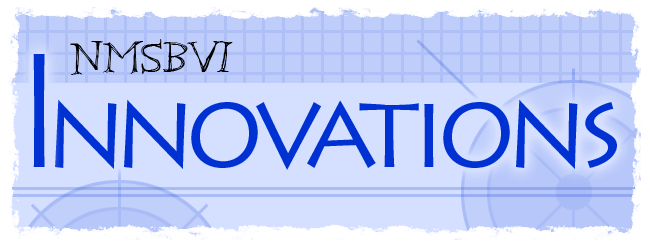
At the heart of good education is innovation. In our efforts to meet the needs of blind & visually impaired students, NMSBVI staff have developed some new tools. We're very proud to share a few of our innovations with you... and hope that you will find them useful in your efforts to make education an exciting process for your own students.
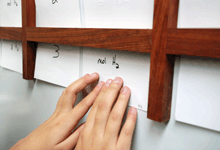
The System for Conceptualizing Spatial Concepts or, (SC)2,
is an instructional tool developed within my chemistry classes at the New Mexico
School for the Blind. By utilizing a system of beveled and magnetized
blocks affixed to a magnetic white board, (SC)2 allows students with
visual impairments to spatially arrange, manipulate, and calculate complex
mathematical and scientific formulae by simply inserting 3 x 5 cards that
students have brailled with values and labels of each term. It provides
individuals with visual impairments equal access and participation in the
classroom while encouraging higher order thinking and greater scientific and
mathematical literacy for blind students.
Click here for more detailed
information about (SC)2
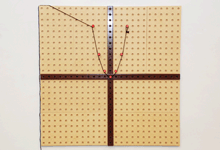
Touch Grids is an instructional tool developed within the
physics classes at the New Mexico School for the Blind and Visually Impaired.
Touch Grids facilitate greater mathematic and graphical literacy through the
conceptualization of many graphical processes that utilize quantitative data by
using a series of connectable and interchangeable grid panels, axes, and pegs.
Possessing universal design features, this educational tool allows students with
visual impairments the ability to bypass their visual deficiencies and gain
greater independence, success, and ultimately access to advanced study or
employment in STEM fields (acronym for Science, Technology, Engineering and
Mathematics).
Click here for more detailed
information about Touch Grids.
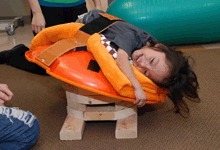
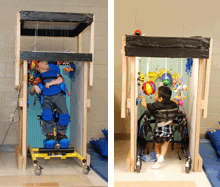
The Tall(er) Room is an offshoot of the Little Room. Some
students, due to health reasons (primarily congestion and swallow issues), can’t
spend extended periods of time supine on the floor or a resonance board. Others
don’t have the same range of motion when on the floor that they do when
supported in a chair. Still others would benefit from standing (either in a
stander or gait trainer) while hand/arm motions are encouraged. Unlike a fixed
height Little Room (either the standard height or one with 4’ vertical posts),
the Tall(er) Room allows the teacher to raise or lower the roof to meet student
need. It is tall and can get taller.
Click here for more information
about
Tall(er) Room.
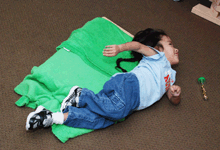
The Instability Board is a simple device designed to help students with multiple impairments begin to roll
over without the physical assistance of others. A student is placed on the board either in the prone or supine positions.
The board is set in ‘neutral’, so that movement by the student to the left or right causes the board to tip to that side.
The student is then rolled off of the board and onto the floor, the surface of which is covered by a pad, mat or blanket.
Click here for more
detailed information about Instability Board.
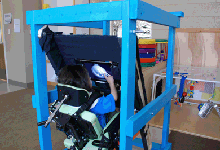
The DIMC (Drive In Media Center) was designed to allow students
with positional issues to access a variety of media options. Computer screens,
for example, are generally presented upright & perpendicular to the surface on
which they are placed. While screens can often be tilted a few degrees the
possible angles traditionally available don’t meet the needs of all students. It
became clear that the solution was to allow for a far greater range of viewing
angles. The DIMC was designed to allow a screen to be presented at several
different angles along a 90 degree arc from perpendicular to the floor all the
way to parallel to the floor.
Click here for more information about
DIMC.
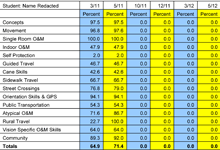
The NMSBVI Orientation & Mobility (O&M) Inventory was developed as a
means of quantifying student progress across the many areas that make up O&M.
The goal was to create a user friendly assessment tool that quickly allowed an
O&M to identify areas of need for individual students. Further, there was a need
to structure it in such a way as to allow paperwork averse O&Ms to easily track
student progress over time. The Inventory aspires to meet these needs. The (M)Inventory
is designed for students with multiple impairments and the (B)Inventory for
students from birth through pre-school.
Click
here for more information about O&M Inventory.
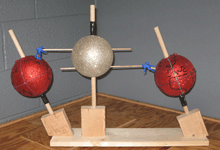
O&Ms often use the position of the sun as an integral part of
cardinal directions. The sun rises in the east, is overhead around noon and sets
in the west. Unless it’s winter at American/European latitudes.…then the sun
rises kind of in the southeast, is off to the south around noon and sets in the
southwest. The Winter/Summer Sun Position Model is a quick and easy visual and
tactual way of showing students why the sun appears to be in different places in
the winter and summer. As an added bonus, science teachers can use it in
conjunction with other solar models and social studies teachers may find it
helpful for explaining latitude and longitude.
Click here for more
information about the Sun Position Model.
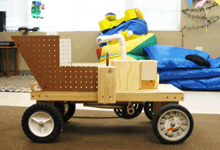
Students with multiple impairments sometimes are unable to control
and move each of their four limbs. This tends to lead to limitations regarding
independent mobility. A student with cerebral palsy, for example, might not ever
have the ability to walk. Such students tend to be wheelchair bound. Standard
wheelchairs, with rims that allow for the operator to control the wheelchair, at
times can’t be controlled by the student due to limitations to range of motion
in the upper extremities. The T-Car, so named due to the T shaped control
handle, was devised to give students with limited control over their limbs the
opportunity to get from Point A to Point B under their own steam. More
information about T-Car coming soon....
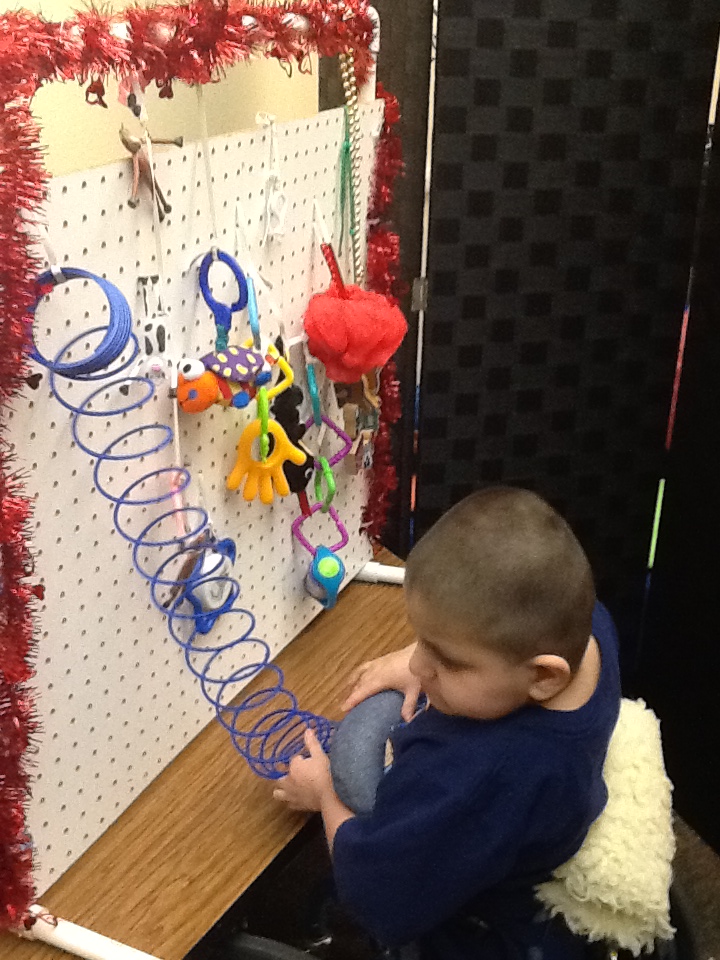
Activity Board.
Please read the Terms And
Conditions Of Use carefully before using this site.
If you do not agree to these terms and conditions of use, please do not use
this site.
Comments to: webmaster@nmsbvi.k12.nm.us
Last Updated: 02/12/14